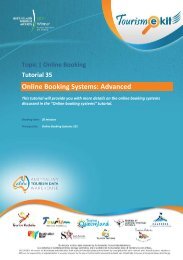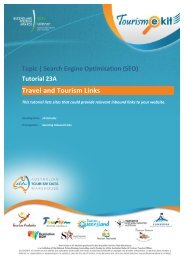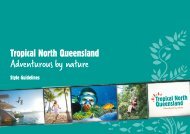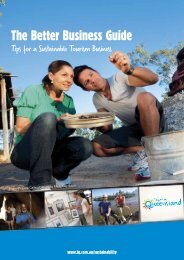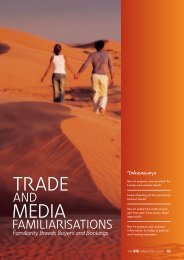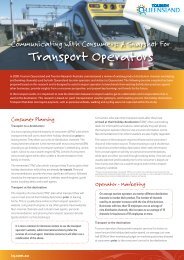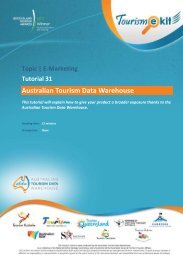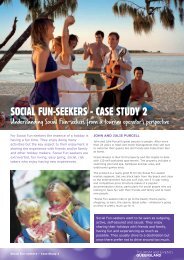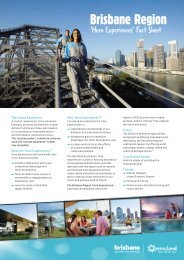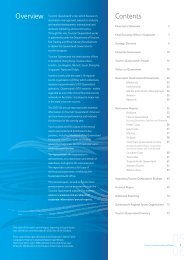Outback Education Handbook PDF - Tourism Queensland
Outback Education Handbook PDF - Tourism Queensland
Outback Education Handbook PDF - Tourism Queensland
You also want an ePaper? Increase the reach of your titles
YUMPU automatically turns print PDFs into web optimized ePapers that Google loves.
28<br />
Rare<br />
Quirky fact :<br />
beauty inspired by<br />
riparian eco-systems<br />
In 1997 there were 256 bird, 56 mammal, 94 reptile and 23 amphibian<br />
species recorded for the Mulga Land bioregion. The eucalypt woodlands<br />
showed the highest diversity of species.<br />
Curriculum Information<br />
Year<br />
Learning and Assessment (Place and Space)<br />
6 Natural Resources - Provision of Energy<br />
7 Sustaining the <strong>Outback</strong> - Renewable Energy Schemes<br />
Description<br />
The native bush that skirts many inland billabongs or stretches along the banks of inland rivers conjures up<br />
images of peace and quiet. However, these ‘riparian’ areas are in fact teeming with wildlife. Riparian describes<br />
the land that lies between the bed of any natural watercourse, creek, river or wetland and the surrounding<br />
terrain. They are narrow corridors that vary in width from just a few metres to more than one kilometre.<br />
A constant water supply combined with fertile alluvial soil and sand deposits create riparian conditions. These<br />
areas sustain a vast array of unique habitats for native plants and animals, as well as being highly valued for<br />
their agricultural benefits. The availability of water, shade, shelter and food not only supports resident wildlife but<br />
also many nomadic and migratory species.<br />
In <strong>Queensland</strong>’s <strong>Outback</strong>, open woodlands of large<br />
river red gum, coolibah and varieties of eucalypt<br />
commonly line the rivers and creeks. Shrubs provide<br />
a thick blanket of undergrowth and after periods of<br />
flooding, the ground becomes lush with grasses,<br />
sedges and forbs. Floods also bring hundreds<br />
of water birds including pelicans, herons, egrets,<br />
cormorants and spoonbills to roost in the trees or<br />
hunt for fish. Once the water subsides and waterholes<br />
become fished out, these birds move away.<br />
Riparian zones are home to birds, mammals, frogs,<br />
reptiles and invertebrates. Koalas are common in<br />
riparian woodlands. The hollows of trees provide<br />
breeding sites for brushtail possums, gliders, owls<br />
and insectivorous bats. Water rats fish in waterholes<br />
at night and by day nest in burrows and hollow<br />
logs. Small birds feed on insects prevalent in the<br />
undergrowth while the kingfisher feeds on small fish,<br />
crustaceans and water insects. Fallen timber and<br />
leaf litter provide habitat for invertebrates, frogs and<br />
reptiles and migratory animals such as flying-foxes,<br />
honeyeaters and some parrots travel long distances<br />
each year to seek out blossom-laden eucalypts.<br />
Riparian areas are fragile and can be easily<br />
damaged. Major threats include: over-grazing;<br />
clearing; feral animals and weeds; changes in water<br />
flow; pollution; and high recreational use.<br />
Riparian habitat in Western <strong>Queensland</strong> BP1319<br />
October00 Product of Habitat Case Studies<br />
Gregory River<br />
070<br />
<strong>Queensland</strong>’s <strong>Outback</strong> <strong>Education</strong> <strong>Handbook</strong> | Natural <strong>Outback</strong>




